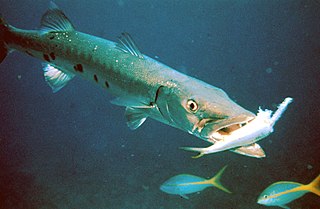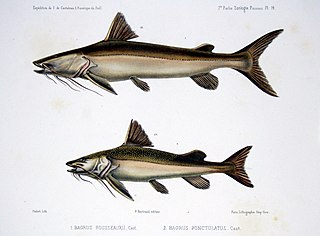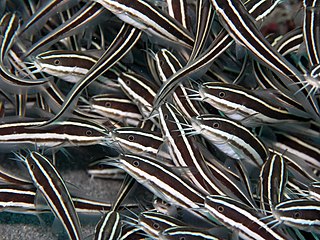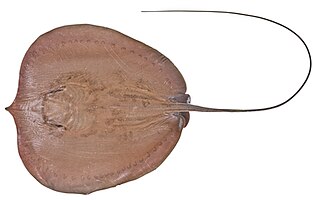
Catfish are a diverse group of ray-finned fish. Named for their prominent barbels, which resemble a cat's whiskers, catfish range in size and behavior from the three largest species alive, the Mekong giant catfish from Southeast Asia, the wels catfish of Eurasia, and the piraíba of South America, to detritivores, and even to a tiny parasitic species commonly called the candiru, Vandellia cirrhosa. Neither the armour-plated types nor the naked types have scales. Despite their name, not all catfish have prominent barbels or "whiskers". Members of the Siluriformes order are defined by features of the skull and swimbladder. Catfish are of considerable commercial importance; many of the larger species are farmed or fished for food. Many of the smaller species, particularly the genus Corydoras, are important in the aquarium hobby. Many catfish are nocturnal, but others are crepuscular or diurnal.

A barracuda is a large, predatory, ray-finned fish known for its fearsome appearance and ferocious behaviour. The barracuda is a saltwater fish of the genus Sphyraena, the only genus in the family Sphyraenidae, which was named by Constantine Samuel Rafinesque in 1815. It is found in tropical and subtropical oceans worldwide ranging from the eastern border of the Atlantic Ocean to the Red Sea, on its western border the Caribbean Sea, and in tropical areas of the Pacific Ocean. Barracudas reside near the top of the water and near coral reefs and sea grasses. Barracudas are targeted by sport-fishing enthusiasts.

Airbreathing catfish comprise the family Clariidae of the order Siluriformes. Sixteen genera and about 117 species of clariid fishes are described; all are freshwater species. Other groups of catfish also breathe air, such as the Callichthyidae and Loricariidae.

The Ariidae or ariid catfish are a family of catfish that mainly live in marine waters with many freshwater and brackish water species. They are found worldwide in tropical to warm temperate zones. The family includes about 143 species.

The speartooth shark is a rare species of river shark, belonging to the family Carcharhinidae. It inhabits coastal marine waters and tidal reaches of large tropical rivers in northern Australia and New Guinea. Despite being a member of the river shark genus, it is also found in near-shore marine waters, favoring highly turbid environments over a wide range of salinities. This robustly built, gray-colored shark is characterized by a short and broad snout, tiny eyes, a relatively large second dorsal fin, and a black blotch beneath each pectoral fin near the tip. Another identifying trait is its teeth, which are large, triangular, and serrated in the upper jaw and narrow, spear-like, and serrated only near the tips in the lower jaw. Adults grow to about 2.6 m (8.5 ft) long.

Brachyplatystoma is a genus of catfish from the family Pimelodidae. As the occasionally used common name goliath catfishes indicates, this genus includes some of the largest species of catfish, including the piraíba, B. filamentosum, which reaches up to the region of 3.6 metres (12 ft) in length. Brachyplatystoma are found in the Amazon and Orinoco basins, and other tropical freshwater and brackish habitats in South America. Some species are migratory. These fish are important as food fish and, to some extent, aquarium fish.

Bagarius is an Asian genus of catfishes of the family Sisoridae. It includes five to six extant species and potentially one extinct fossil species, B. gigas.
Breitensteinia is a genus of catfishes of the family Akysidae. It includes three species.

Plotosus is a genus of eeltail catfishes native to the Indian Ocean, the western Pacific Ocean and New Guinea.

The bayad, is a species of bagrid catfish from Africa.

Eleutheronema tetradactylum, the fourfinger threadfin, known as ranwas in Pakistan, is a species of marine ray-finned fish, a threadfin from the family Polynemidae which occurs in the Indian and western Pacific Ocean.

The giant pangasius, paroon shark, pangasid-catfish or Chao Phraya giant catfish is a species of freshwater fish in the shark catfish family (Pangasiidae) of order Siluriformes, found in the Chao Phraya and Mekong basins in Indochina. Its populations have declined drastically, mainly due to overfishing, and it is now considered Critically Endangered.

Neoarius berneyi, the highfin catfish, Berney's catfish, Berney's shark catfish, or the lesser salmon catfish, is a freshwater sea catfish that is commonly kept in aquariums. The origin of the name Neoarius berneyi is Greek, with the genus name Neoarius coming from the words neos meaning new and arios, meaning warlike or hostile, in reference to the well developed fin spines, and the species name, berneyi, comes from the ornithologist F. L. Berney.

The king threadfin, also known as the blind salmon, blink tassel-fish, burnett salmon, gold threadfin, king salmon, kingfish, Sheridan threadfin, triped tassel fish, or threadfin salmon, is a species of marine ray-finned fish, a threadfin from the family Polynemidae which is found in southern New Guinea and northern Australia.

The freshwater whipray is a little-known species of stingray in the family Dasyatidae, found in a number of large rivers and associated estuaries in northern Australia. Until recently, this species was regarded as a regional subpopulation of the similar-looking but much larger giant freshwater stingray of Southeast Asia. Typically reaching 1 m (3.3 ft) across, the freshwater whipray has a distinctively shaped, rounded pectoral fin disc, a projecting snout, and a thin tail without fin folds. It is plain brown above and white below with dark marginal bands. It may occasionally travel onto land and can "breathe" out of water for up to 7 minutes. The freshwater whipray is an active hunter of small fishes and shrimps, and does not currently face substantial conservation threats.

The Australian blackspot shark or Coates's shark is a species of requiem shark found off northern Australia and possibly also off the coast of New Guinea. It belongs to a species complex of Blackspot sharks in the family Carcharhinidae. These sharks are not widely studied due to their cryptic nature, but there was a recent reclassification distinguishing it from the Whitecheek shark and the Blackspot Shark in 2012. Much of the existing literature predates this reclassification and groups the Australian blackspot shark with the aforementioned closely related species.
Neoarius leptaspis, the salmon catfish, boofhead catfish, freshwater forked tailed catfish, lesser salmon catfish, or triangular shield catfish, is a species of catfish in the family Ariidae. It was described by Pieter Bleeker in 1862, originally under the genus Hexanematichthys. It inhabits marine, brackish and freshwaters in Australia and New Guinea, at a maximum known depth of 135 m (443 ft). It reaches a maximum standard length of 60 cm (24 in).
Neoarius latirostris, the broad-snouted catfish, is a species of catfish in the family Ariidae. It was described by William John Macleay in 1883, originally under the genus Arius. It inhabits freshwater rivers in Indonesia and Papua New Guinea. Its diet includes finfish, mollusks, prawns, terrestrial arthropods, aquatic insects, and plants. It reaches a maximum standard length of 50 cm (20 in).
Neoarius pectoralis, the sawspine catfish or sawspined catfish, is a species of catfish in the family Ariidae. It was described by Patricia J. Kailola in 2000, originally under the genus Arius. It inhabits marine and brackish waters in Australia, Irian Jaya, and possibly also Papua New Guinea. It reaches a maximum fork length of 39.3 cm (15.5 in).
Neoarius utarus, the northern rivers catfish or salmon catfish, is a species of catfish in the family Ariidae. It was described by Patricia J. Kailola in 1990, originally under the genus Arius. It inhabits freshwater bodies in Indonesia and Papua New Guinea.















